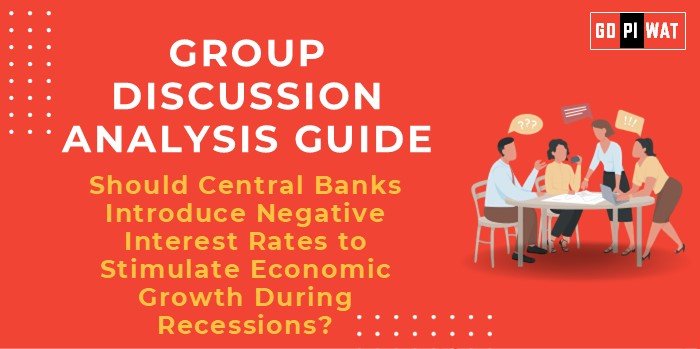📋 Group Discussion (GD) Analysis Guide: Should Central Banks Introduce Negative Interest Rates to Stimulate Economic Growth During Recessions?
🌐 Introduction to the Topic
Opening Context: The global economy has seen unprecedented challenges, especially during periods of economic downturn. Negative interest rates, once a theoretical concept, have become a practical tool used by several central banks worldwide, including in Japan and the Eurozone, to combat recessionary pressures.
Topic Background: Negative interest rates aim to incentivize borrowing and spending by penalizing banks for holding excess reserves. While this unconventional monetary policy has stirred debate, it remains a pivotal topic for B-school discussions, given its impact on economic growth, inflation, and financial stability.
📊 Quick Facts and Key Statistics
- 📉 ECB Negative Rates (2014–2022): Eurozone saw negative rates on deposits, spurring lending but with mixed long-term growth outcomes.
- 🇯🇵 Japan’s Policy: Introduced in 2016, resulted in modest GDP growth but failed to hit the 2% inflation target.
- 🌍 Global Application: 6+ countries have experimented with negative rates since 2009, signaling its global relevance.
- 🇺🇸 US Context: Federal Reserve has avoided negative rates, preferring quantitative easing.
🧑🤝🧑 Stakeholders and Their Roles
- 🏛️ Central Banks: Implement and regulate negative rate policies.
- 🏦 Commercial Banks: Adapt lending strategies, often facing reduced margins.
- 👥 Consumers and Businesses: Beneficiaries of lower borrowing costs, though savings are penalized.
- 🏢 Government Entities: Depend on central bank strategies to stabilize economies.
- 🌐 Global Institutions (IMF, World Bank): Analyze and critique policy efficacy globally.
🏆 Achievements and Challenges
🎯 Achievements:
- Boosted liquidity in banking systems (e.g., ECB led to a 20% lending increase).
- Encouraged spending by reducing the incentive to save.
- Helped stabilize deflationary pressures in regions like Japan.
⚠️ Challenges:
- Financial Stability: Increased asset price bubbles due to excessive liquidity.
- Bank Profitability: Reduced margins have hurt banking profitability globally.
- Consumer Behavior: Limited impact on stimulating demand due to cautious consumer spending.
Global Comparisons:
• Sweden: Transitioned out of negative rates in 2019 after achieving modest growth but limited inflation impact.
• Japan: Struggles with deflationary pressure despite prolonged negative rates.
📋 Structured Arguments for Discussion
- Supporting Stance: “Negative rates are an effective last-resort tool, ensuring liquidity and encouraging economic recovery in recessionary periods.”
- Opposing Stance: “Negative rates distort financial markets, penalize savers, and may lead to long-term financial instability.”
- Balanced Perspective: “While negative rates offer temporary relief during downturns, they must be complemented by fiscal policies to achieve sustainable growth.”
💬 Effective Discussion Approaches
- 💡 Opening Approaches:
- “In the Eurozone, lending grew by 20% under negative rate policies.”
- “While Sweden successfully exited negative rates, Japan continues to struggle, indicating mixed efficacy.”
- “Negative rates challenge conventional monetary economics, offering a novel yet controversial approach to managing recessions.”
- 💡 Counter-Argument Handling:
- Highlight the necessity of complementary fiscal measures.
- Compare with alternative monetary tools like quantitative easing.
- Reference global case studies to substantiate points.
📈 Strategic Analysis of Strengths and Weaknesses
Strengths:
- Encourages borrowing.
- Prevents deflation.
- Spurs economic activity.
Weaknesses:
- Hurts bank margins.
- Risks financial bubbles.
- Limited consumer impact.
Opportunities:
- Can stabilize economies when fiscal tools are exhausted.
Threats:
- Prolonged use may destabilize financial systems.
- Erodes confidence in monetary policies.
📚 Connecting with B-School Applications
- Real-World Applications: Monetary policy design for financial courses, analyzing the interplay between fiscal and monetary tools.
- Sample Interview Questions:
- 🧐 “Can negative interest rates sustainably boost economic growth?”
- 📘 “How do negative rates compare with quantitative easing as a policy tool?”
- Insights for Students: Explore case studies of Japan and Sweden for monetary policy research, investigate the relationship between negative rates and inflation dynamics.


